Introduction
- Organizations develop certain philosophies or ways of doing their own goings-on over time.
- This mode of administration leads to the formation of organizational culture.
- Organizational culture is a critical subject in modern organizations. It requires verification, quantification, and validation of organizational structures.
- It serves as an important dimension that guides organizational analysis.
- Organizational culture comprises all values, norms, and behaviors among other aspects that govern the functions of the operational structures of an organization.
- These aspects of an organization require periodic review through various survey methodologies and instruments to ensure that their functionality remains valid with reference to the changing consumer demands.
- Different organizational structures vary in complexity and changeability, owing to the nature of the external and internal factors that determine the ultimate functionality of the organizations.
Organizational culture is a mode of working that specifies how employees need to interact with one another and the organization. It specifies the expectations of all workers. Assessment of organizational culture is important to plan for implementation of organizational change. Different organizations engage in particular diagnosis methodologies to meet the specific needs that arise within them. Consequently, organizational culture demands the understanding of the organization’s status quo prior to examination, quantification, and validation of the individual organizational units. To achieve this knowledge, there is always a need to conduct an organizational evaluation using appropriate survey methodologies and instruments.
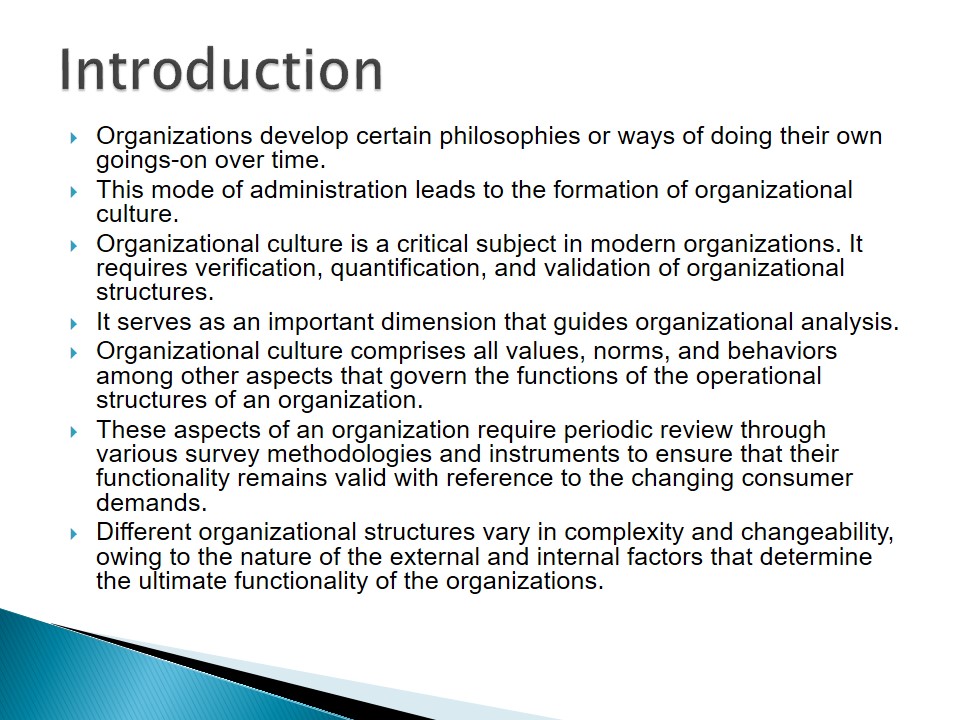
Organizational Culture Survey Methodologies and Instruments Available for Purchase
- The assessment of an organization involves the use of various survey methodologies and instruments.
- The widely used tool in organizational assessment is the Organizational Culture Assessment Instrument (OCAI).
- The consequences of the OCAI survey methodology entail assessment of several philosophy categories of the CVF.
- The categories include racial traditions, adhocracy customs, bazaar ways of life, and hierarchy customs. Figure 1 shows these categories
- Since the OCAI is founded on the Competing Values Framework, it is possible to examine and analyze a vast scope of organizational occurrences.
- The four types of organizational cultures correspond to the quadrants of the Competing Values Framework, which include flexibility versus stability and internal focus versus external focus.
- Organizational Culture Questionnaire (OCQ) is another instrument that enables the examination of the human factors within an organization.
- This survey instrument explores values, attitudes, and general behaviors of an organization’s workforce through rigorous comparison of individual efforts and the accomplishment of the overall organizational goals and objectives.
- Due to the nature of humanity, perceptions, values, personalities, and abilities vary amongst diverse individuals within the workplace.
- As a result, profiled group models of persons within an organization lead to the formation of a somewhat organizational philosophy that serves as their unique style of conducting the operations of an organization.
- The OCQ methodology examines the principles, thoughts, and universal performance of an organization across thirteen human factors.
- These human factors include personal level performance, leadership, involvement, competence, communication, customer centeredness, human resource management, and assimilation of organizational goal among others.
- Lastly, the Denison Organizational Culture Survey (DOCS) that has existed over the last two decades is a versatile survey instrument that reviews organizational success across a number of performance indicators.
- Also referred to as the Denison Consulting model, it enables organizations to compare their level of organizational culture against international standards.
- Denison Consulting centers on culture and leadership to enable organizations formulate achievable goals and objectives.
- The DOCS instrument evaluates the successes and failures of the individual functional structures of the organization.
- The results obtained from DOCS enables organizations to develop sound change management strategies to accomplish impending goals and objectives.
- An empowerment index that is obtained from the DOCS methodology is used to make organizational decisions that grant authority, initiative, and abilities both at individual and organizational levels.
Organizational culture survey methodologies and instruments vary greatly depending on the behaviors and attitudes of the existing organizational philosophies. Therefore, assessors need to understand the underlying philosophies of the organization prior to choosing the appropriate methodology and/or instrument of assessment. Each survey methodology and instrument has a core purpose of influencing the value of organizations and their potential to remain competitive in volatile markets. Using the OCAI tool has enabled many organizations around the globe to define and redefine their core values and underlying assumptions in an attempt to accomplish organizational goals and objectives (Cameron & Quinn, 2011).
The OCAI tool is a diagnosis instrument that uses the constructs of the Competing Values Framework (CVF) to conduct organizational culture measurement (Cameron & Quinn, 2011). The validated OCAI research instrument also gives an insight into how such information is related to market and the overall performance of the organizations. However, it is important to reveal that the results obtained from this tool may lead to misrepresentation of the individual behaviors of the organization’s workforce.
The Organizational Culture Questionnaire (OCQ) assesses the culture of an organization by using three aspects, which include obligation, proficiency, and constancy. According to Hartnell, Ou, and Kinicki (2011), these aspects enable evaluators to judge the effectiveness of an organization through comparison of values, attitudes, discernments, and aptitudes among other individualities that are exhibited by the organization’s workforce. A research carried out by the authors indicated that culture varies across different organizational structures and levels. This situation can be an implication of issues within some organizations that require corrective measures.
Perhaps, the Denison Organizational Culture Survey (DOCS) tool is the oldest in determination of organizational success. The tool uses multifarious performance indicators in areas such as marketing, production, and operations among others to enable organizations formulate sound decisions on critical organizational issues with reference to mergers, acquisitions, leadership transformation and empowerment, assimilation of goals and objectives, and change management among other issues (Russo & Harrison, 2005). According to the authors, alignment of organizational culture and leadership is the focus of the DOCS tool.

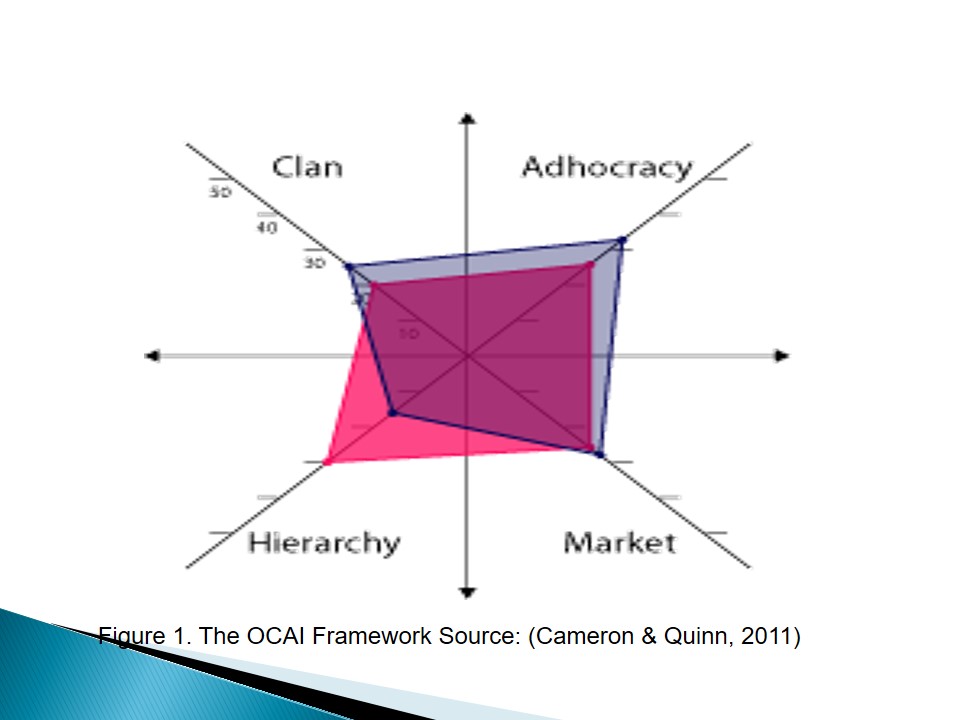

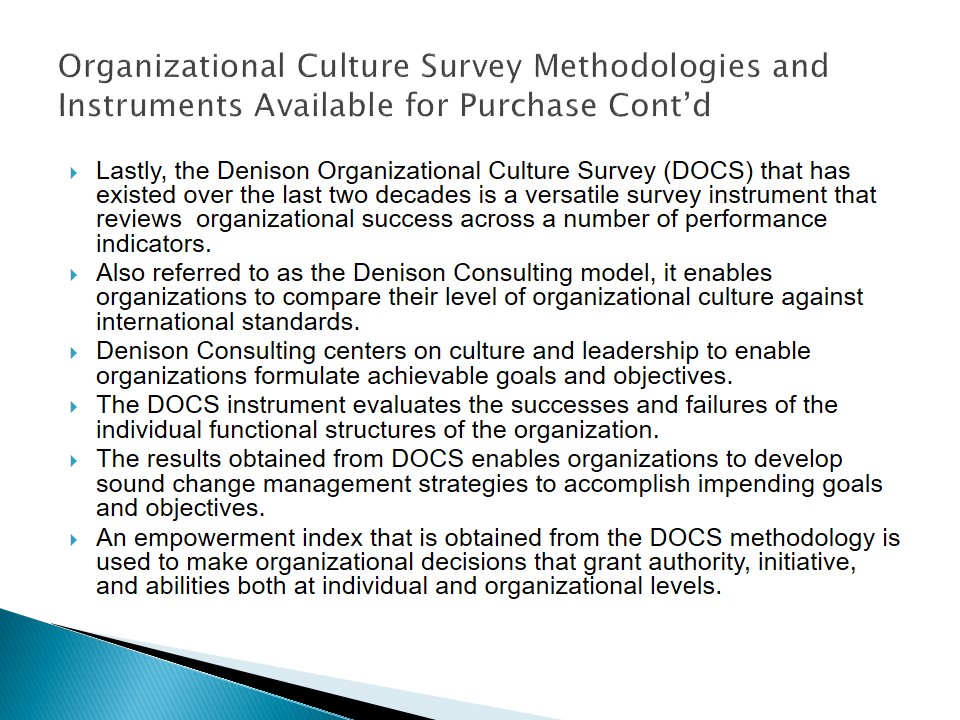
Purpose, Costs, and Benefits of survey methodologies and Instruments
- The purpose of the OCAI instrument is to provide organizations validated information about their organizational culture by measuring the six core dimensions of organizational culture.
- The OCAI survey instrument has multifarious benefits. Firstly, it presents the organization with validated and quantified information about the organizational culture, which forms a strong baseline for change processes.
- Secondly, the OCAI methodology is time-bound since it focuses on the assessment of the key factors that influence the accomplishment of change.
- Thirdly, this survey methodology is practicable and convenient ,owing to its systematic process.
- The major cost of the OCAI tool is that it presents an organization with generalized findings of the behaviors of the employees.
- Hence, the process can generate biased decisions.
- On the other hand, the purpose of the Organizational Culture Questionnaire (OCQ) is to prepare the organization for processes such as change, mergers, or acquisitions.
- It enables the formulation of feasible decisions towards such processes to improve the organizational performance.
- In addition, the Organizational Culture Questionnaire enables an organization to reduce the gap between employees by examining their present attitudes towards each other and the organization.
- One of the greatest benefits of the OCQ is that it enables the organization to appraise leadership behavior of individual employees.
- Lastly, the Denison Organizational Culture Survey (DOCS) instrument’s main purpose is to examine how the traits of the various resources of an organizations affect its bottom line.
- There exists a connection between the traits of the existing culture or cultures of an organization and the overall accomplishment of goals and objectives.
The purpose of each survey methodology and instrument has some accompanying costs and benefits. The OCAI is an organizational culture measurement tool that can deliver results of the current or expected culture in less than 20 minutes. The OCAI tool focuses on the generation of significant effects on the performance of organizations. According to the Cameron and Quinn (2011), the tool takes into consideration the contribution of each individual towards the success of an organization. Employee traits such as morale, involvement, carnal health, and productivity among others are correlated with the attainment of competitive advantage to determine the level of accomplishment of organizational goals (Kordshouli, Baneshi, & Rezaei, 2013).
Russo and Harrison (2005) posit that the Organizational Culture Questionnaire (OCQ) facilitates the measurement of corporate culture in organizations. It also evaluates the power gap that exists amongst employees and their managers The OCQ seeks the responsibility of individual employees in terms of making their own decisions. In addition, the OCQ provides a distinct image of the appropriate culture that the organization can develop to mobilize organizational resources for successful change. According to Denison, Nieminen, and Kotrba (2014), DOCS model provides an insight into how the individual and common traits influence the bottom line of the organization.
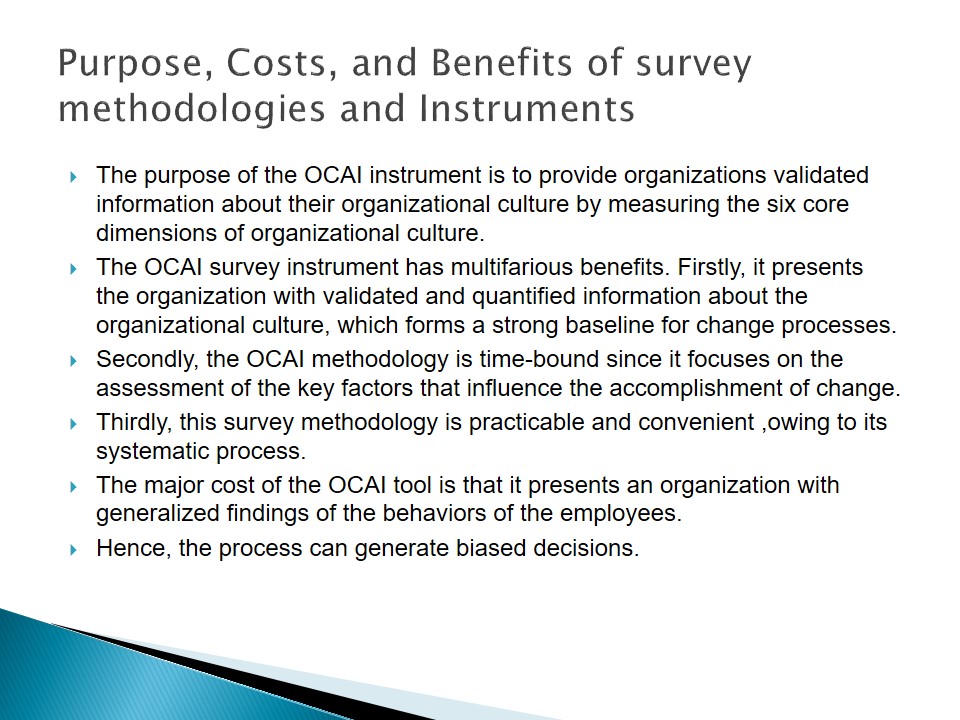

Matrix of Companies
The above matrix presents 3 companies, namely Nampak Tissue – Riverview Paper Mill, Henkel, and La Community Bank. The matrix shows how the respective companies have applied the discussed tools (OCAI, DOCS, and OCQ). The matrix also shows the various benefits that each company has enjoyed after applying the respective organizational culture tools. However, it is crucial to also capture the cost of using the tools, their degree of effectiveness, and the mode of promoting organizational culture by the respective companies, as presented in the matrix.
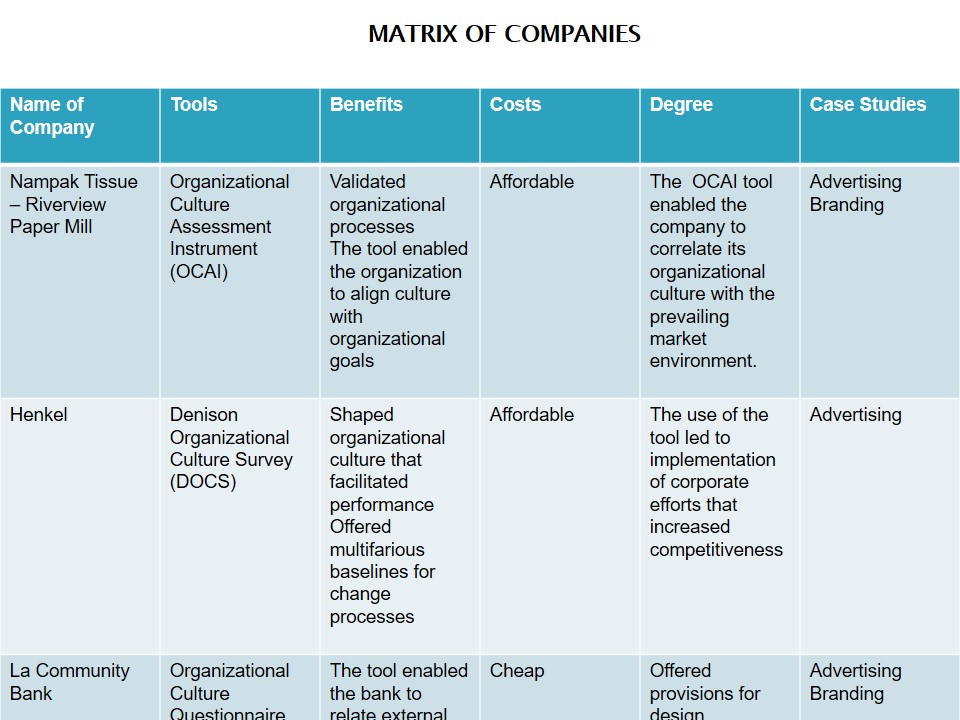
Degree to which each of the Tools help in the Assessment of Organizational Processes
- The OCAI process examines how the organizational culture affects the achievement of organizational targets by using the Competing Values Framework to determine the effectiveness of the organization.
- The CVF specifies the criteria of assessment in areas such as flexibility, steadiness, design, and productivity of organizational structures.
- The CVF also evaluates the analogy and strength of organizational structures with respect to the existing standards of organizational cultures.
- The OCQ tool uses thirteen human factors to determine the critical issues that need adjustment for organizational effectiveness.
- The OCQ assessment tool evaluates subjective sentiments such as employee values, attitudes, and general behavioral norms that contribute to the prevailing organizational culture.
- The DOCS tool uses its diagnostic processes to initiate the alignment of organizational culture and leadership.
The tools assess the functions and contributions of employees in both individual and team levels. However, different individuals develop certain behaviors that build exclusive organizational philosophies. As a result, the extent of organizational assessment closely relates to the status quo of the existing cultures and the evaluation tool to be used. The tools also use varying criteria to come up with reliable conclusions that determine the effectiveness of organizations. For instance, while the OCAI tool adheres to the Competing Values Framework, the OCQ assumes an examination of various human factors (Russo & Harrison, 2005). The DOCS methodology provides rich information of the organizational culture patterns by distinguishing the cultural characteristics that promote the accomplishment of goals from traits that deter organizational success (Hartnell et al., 2011).
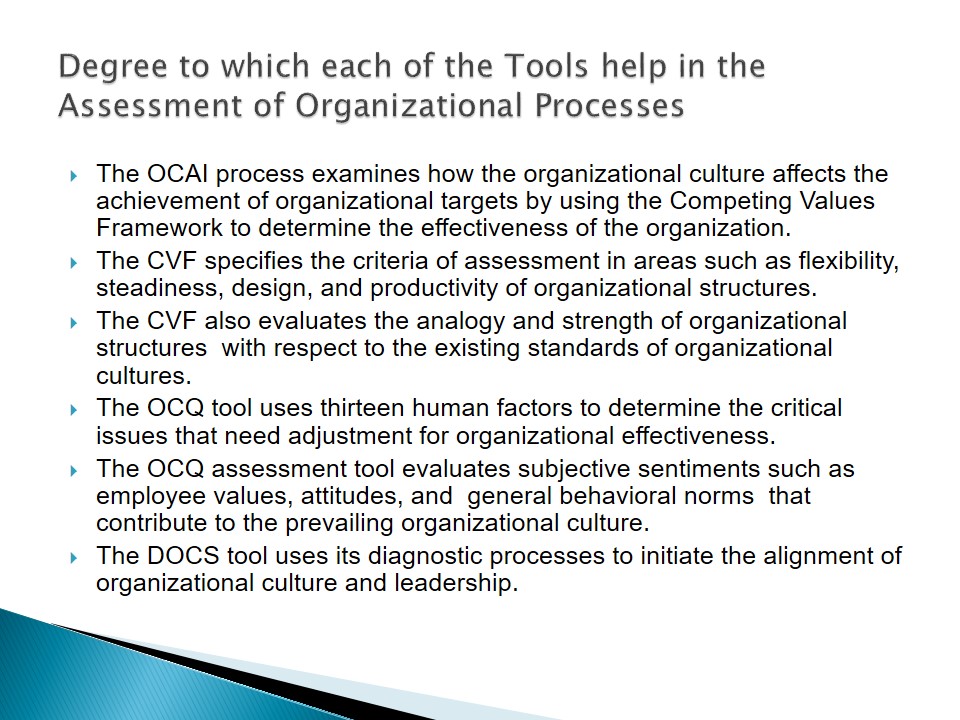
Conclusion
- The assessment of an organizational culture is unavoidable for vibrant organizations that seek competitive advantage in today’s dynamic markets.
- Contemporary business environments have become increasingly competitive . Organizations have to catch up or maintain their operations through the establishment of viable decision making processes.
- Survey methodologies and instruments enable the determination of organizational strengths and weaknesses through their distinctive means to facilitate the process of decision making that leads to successful change.
- Each organization is unique in culture composition . It requires the determination of appropriate survey methodology and instruments.
- The general importance of assessment tools is to accentuate the formulation of apt decisions that lead to the execution positive organizational change.
- Therefore, there is a need for organizations to conduct evaluations in an attempt to maintain organizational effectiveness.
As new technologies continue to pool in the entrepreneurial world, businesses have to alter their old tricks to new tactics that can sustain their operations. The assessment of organizational effectiveness has become an inevitable practice. Organizations have to strive by all means to match market competition for goods and services. To achieve this objective, they have to assess their own cultures against the overall performance of the organization using survey methodologies and instruments to facilitate the deliberation of critical decisions for accomplishment of performance goals.
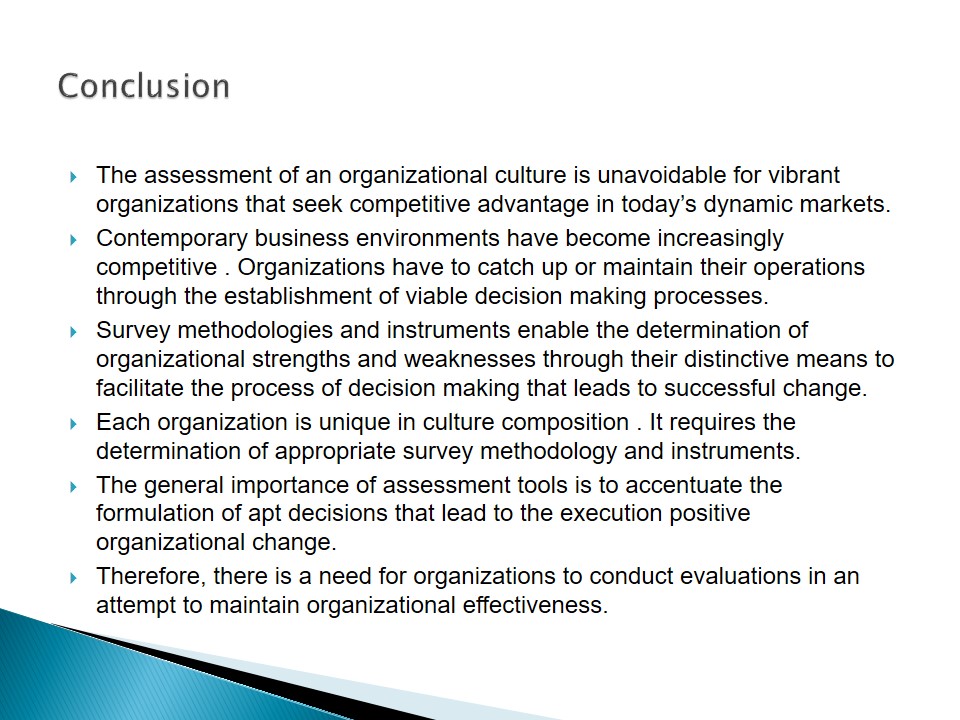
Reference List
Cameron, S., & Quinn, E. (2011). Diagnosing and Changing Organizational Culture: Based on the Competing Values Framework. United Kingdom: Jossey-Bass.
Denison, D., Nieminen, L., & Kotrba, L. (2014). Diagnosing organizational cultures: A conceptual and empirical review of culture effectiveness surveys. European Journal of Work & Organizational Psychology, 23(1), 145-61.
Hartnell, A., Ou, A., & Kinicki, A. (2011). Organizational culture and organizational effectiveness: A meta-analytic investigation of the competing values framework’s theoretical suppositions. Journal Of Applied Psychology, 96(4), 677-94.
Kordshouli, R., Baneshi, E., & Rezaei, B. (2013). Depicting favorite organizational culture: An empirical case study. Management Science Letters, 3(11), 2839-46.
Russo, V., & Harrison, S. (2005). Organizational Design and Environmental Performance: Clues from the Electronics Industry. Academy Of Management Journal, 48(4), 582-93.